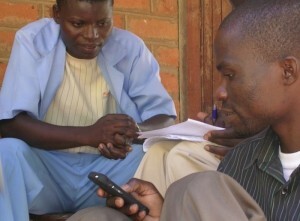When we discuss connected health on the blog, most of the time it is in relation with progress made for patient care, self-treatment, or some form of tele-medicine. Today, we take a look at how technology makes a difference is the way governments, NGOs and other institutions tackle international health issues.
We discussed before on the blog the ChildCount+ initiative that aims to reduce child and maternal mortality in sub-Saharan Africa by using SMS to coordinate community health workers. SMS are also used in the “SMS for life” initiative, also in Central Africa, to help fight malaria. One of the key issues of malaria medicine distribution in rural areas of Africa is the difficulty of managing stocks in remote health centers. Regular means of reporting are slow and not always accurate and forecasting demand is extremely difficult when even the care providers have irregular interaction with the people under their purview. By designing templates for SMS reports and sticking to a weekly schedule, the local authorities were able to greatly improve the availability of antimalarial medicine.
E-health technology is also used in several projects around the world for tracking and managing the outbreak of epidemics. Developed by the non-profit organization DataDyne, EpiSurveyor is a tool that works on most phones and that lets you create custom forms that you can then send to a list of contacts for them to fill. While the system can be used for any sort of survey, it was first designed as a way to retrieve data quickly and in a form that is easy to exploit during an epidemic outbreak or some other emergency situation. EpiSurveyor is cheap, easy to use and has been deployed in over 160 countries in the world. For instance, EpiSurveyor has been used in 2010 to monitor the vaccination effort in Kenya against the H1N1 influenza pandemic.

Another innovation, born with the Internet generation, is crowdsourcing. It turns out that even with very complex matters, many times tens of thousands of untrained brains can be better than a few hundred qualified ones. For instance, in August 2011, scientists released a web-based game named “Foldit” where players were challenged to find how molecules would fold onto each other in three dimensions. The ultimate goal was to try to find how an enzyme with a structure similar to the aids virus behaved, which would help understand how the disease itself functioned. It took the players three weeks to succeed where scientists had failed for ten years.

The problem was not the scientists’ intelligence, rather the issue was that computers are just not very good at spatial reasoning and the researchers themselves cannot afford the hundreds of hours necessary to solve such puzzles: their very specialized skills always find a more pressing use. By multiplying the available brain power by a factor of a thousand and using modern tools to create a user-friendly interface and a social environment to debate and compare various solutions, crowdsourcing made it possible to make progress and crack the puzzle.
And you, can you think of any other global health issues that could benefit from connected health technology?


